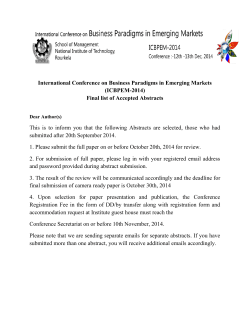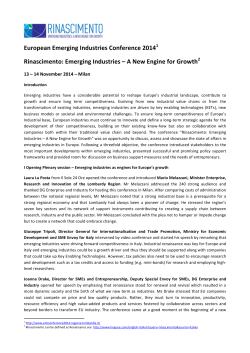
Chapter Nine Local Marketing in New Growth Markets MKT568 Global Marketing Management
3-1 Chapter Nine Local Marketing in New Growth Markets MKT568 Global Marketing Management Dr. Fred Miller Scenario Krutsch SA is a Swiss manufacturer of small electrical kitchen appliances (blenders, coffee makers, food processors etc). The firms offers several types of appliances with multiple models in each line. These differ in styling and features to serve diverse segments based on patterns of kitchen use. Promotion builds each brands image and focuses on the value of each model for its target segment. Prices vary from discount to expensive in each line, but are slightly above competitors’ prices at each product level. The firm sells across Europe through department stores, mass merchandisers, hardware stores, online retailers and its own eBusiness Web store. In international markets the firm must maintain its brand image by managing its manufacturing and marketing processes very tightly. An Optimal Entry Mode Matrix Company strategic posture Emerging High-growth Mature Services Incremental Indirect exports Indirect exports Direct exports Licensing/ Alliance Protected Joint venture Indirect exports Alliance/ Licensing Licensing Wholly owned subsidiary Acquisition/ Alliance Wholly owned subsidiary Franchising/ Alliance/ Exporting Control Exhibit 6.3 Product/Market Situation Global Marketing Decisions in this Chapter What social and market conditions are dominant in new growth markets? What marketing research tools, strategy and tactics are most appropriate? What general marketing approaches are most effective in new growth markets? How should these strategies be adapted to: Latin America Asia Three Marketing Environments Exhibit 9.1 Feature Life cycle stage Product/Market situation Emerging New growth Mature Intro Growth Mature Tariff barriers High Medium Low Nontariff barriers High Domestic competition Weak Foreign competitors Weak High Getting stronger Strong Medium Strong Strong Financial institutions Consumer markets Industrial markets Political risk Distribution Media advertising Strong Strong Strong Medium Getting stronger Strong Strong Saturated Strong Low Strong In-store promotion Weak Embryonic Getting stronger High Weak Weak Porter’s Diamond Competitive Advantage for Countries Firm strategy, structure and rivalry Factor conditions Demand conditions Related and supporting industries Source: Adapted and reprinted with the permission of the Free Press, a division of Simon and Schuster, from The Competitive Advantage of Nations, by Michael E. Porter. Copyright © 1990 by Michael E. Porter Dominant Marketing Dimensions Product/Market Situation Task Emerging New growth Mature Research focus Feasibility Economics Segmentation Primary data sources Visits Middlemen Respondents Customer analysis Needs Aspirations Satisfaction Segmentation base Income Demographics Life style Marketing analysis: Exhibit 9.2 Dominant Marketing Dimensions Product/Market Situation Task Emerging New Growth Mature Market development Participation in growth Compete for share Competitive Focus Lead/follow Domestic/foreign Strengths/ weaknesses Product line Low end Limited Wide Product design Basic Advanced Adapted New product intro Rare Selective Fast Pricing Affordable Status Value Advertising Awareness Image Value-added Distribution Build-up Penetrate Convenience Promotion Awareness Trial Value Service Extra Desired Required Marketing strategy: Strategic focus Exhibit 9.2 cont. Comparative Statistics Source: World Bank 2002 Area in SQ KM Countries 24% 26% 33% High High 25% Middle Middle Low Low 51% 41% Population Total GNI 80% 15% 3% 41% High High Middle Middle Low Low 17% 44% Distribution of New Growth Markets Global Marketing Decisions in this Chapter What social and market conditions are dominant in new growth markets? What marketing research tools, strategy and tactics are most appropriate? What general marketing approaches are most effective in new growth markets? How should these strategies be adapted to: Latin America Asia Local Marketing in New Growth Markets Raw materials (authoritarian) vs FDI (capitalistic) markets Market analysis trade blocs, introduction/growth stage of PLC, emerging middle class segments favorable view of foreign products Product strategy localization required, adaptation optional, brand support, foreign origin Local Marketing in New Growth Markets Pricing status pricing, tempered with need to build loyalty in low income markets Promotion build brand image for long term potential, intellectual property problems Distribution nurture relationships, invest in channel structure Global Marketing Decisions in this Chapter What social and market conditions are dominant in new growth markets? What marketing research tools, strategy and tactics are most appropriate? What general marketing approaches are most effective in new growth markets? How should these strategies be adapted to: Latin America Asia Latin American Countries and Population United States United States Bahamas, The Bahamas, The Bahamas, The Bahamas, The Cuba Bahamas, The Bahamas, The Mexico Mexico Jamaica Belize Guatemala Honduras El Salvador Nicaragua Haiti Dominican Republic Puerto Rico Antigua & Barbuda Guadeloupe Aruba Martinique St. Lucia Grenada Trinidad and Tobago Costa Rica Panama Venezuela Guyana Suriname French Guiana Colombia Ecuador Population Persons Peru Brazil 56 - 43,410,900 53,142,970 - 258,833,000 Bolivia 894,608,700 - 1,302,862,775 Missing values Paraguay Uruguay Chile Argentina Falkland Islands Chile Marketing in Latin America Market trends Concentration of wealth, common linguistic/religious influences Importance of regional trade groups – NAFTA, LAIA, Mercosur (Argentina, Brazil, Venezuela, Uruguay, Paraguay) 5 associate members Major markets are Argentina, Brazil, Mexico, Chile Pan-regional marketing strategies Market analysis Segmentation: urban/rural and age are major dimensions Positioning: urban similar to mature markets (80% of purchasing power), rural very difficult Marketing in Latin America Marketing strategy Product: language/packaging localization, limited adaptation Price: premium for elite, value for emerging middle class Distribution: weak infrastructure, emerging integrated intermediaries (hypermarkets) Promotion: detailed information, family orientation Global Marketing Decisions in this Chapter What social and market conditions are dominant in new growth markets? What marketing research tools, strategy and tactics are most appropriate? What general marketing approaches are most effective in new growth markets? How should these strategies be adapted to: Latin America Asia Asian Countries and Population Population Persons 56 - 43,410,900 53,142,970 - 258,833,000 894,608,700 - 1,302,862,775 Missing values Marketing in Asian New Growth Markets Market trends Variations in size and ethnic composition Ambivalence toward Japan Recovery from economic crisis reversing trend of rapid economic growth Major markets are South Korea, Taiwan, Hong Kong Pan-regional marketing strategies possible, but risky Leading markets for emerging economies Market analysis Segmentation: urban/rural, ethnic, religious dimensions Positioning: global identification of consumers, especially in emerging middle class Marketing in Asian New Growth Markets Marketing strategy Product: small packages, full lines for “harmonious whole” Price: entry strategy crucial, sensitivity to changes, gray trade risk Distribution: weak rural infrastructure, strong retail sector in urban areas Promotion: message extension, language/culture localization When You Say Bud video What firm-specific advantages are at issue here for Anheuser Busch? for Budejovice Budvar? What entry method did Anheuser Busch attempt to employ in this situation? Why did the firm select this approach? How did Budejovice Budvar respond to this effort? Why? When You Say Bud video Cyprus France, Germany, USA 3-1 Chapter Nine Local Marketing in New Growth Markets MKT568 Global Marketing Management Dr. Fred Miller
© Copyright 2025





















